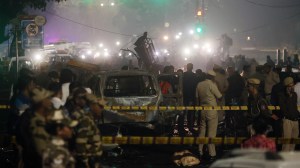March to Modernisation
A $200 billion plan to remake the largest war machine in history unfolds in a small way on a quiet country road in the Chihuahuan Desert, USA.

A $200 billion plan to remake the largest war machine in history unfolds in a small way on a quiet country road in the Chihuahuan Desert, USA.
Jack Hensley, one of a legion of contractors on the project, is hunkered in a slowly moving SUV, serving as target practice for a baby-faced soldier in a Humvee aiming a laser about 700 yards away. A moment later, another soldier in the Humvee punches commands into a computer transmitting data across an expanse of sand and mesquite to a site 21/2 miles away. On an actual battlefield, this is when a precision attack missile would be launched, killing Hensley almost instantly.
In the US Army’s vision, the war of the future is increasingly combat by mouse clicks. It’s as networked as the Internet, as mobile as a cellphone, as intuitive as a video game. The US Army has a name for this vision: Future Combat Systems, or FCS. The project involves creating a family of 14 weapons, drones, robots, sensors and hybrid-electric combat vehicles connected by a wireless network. It has turned into the most ambitious modernisation of the Army since World War II and the most expensive American weapons programme ever, military officials say.
It’s also one of the most controversial. Even as some early versions of these weapons make their way onto the battlefields of Iraq and Afghanistan, members of US Congress, government investigators and military observers question whether the Defence Department has set the stage for one of its biggest and costliest failures. At risk, they say, are billions of taxpayer dollars spent on exotic technology that may never come to fruition, leaving the Army little time and few resources to prepare for new threats.
Future Combat Systems “has some serious problems,” said Neil Abercrombie (D-Hawaii), chairman of the US House air and land forces subcommittee. “Since its inception, costs have gone up dramatically while promised capability has steadily diminished…And now, with the Army’s badly degraded state of readiness from nearly five years of continuous combat in Iraq, I don’t see how the Army can afford to rebuild itself and pay for the FCS program as it stands today.”
The last time the US Army tried anything so far-reaching was more than half a century ago when it introduced mechanised forces, moving soldiers en masse by machine rather than by foot, Army programme officials say. “We are pushing the edge of technology,” said Lt. Gen. Stephen M. Speakes, a leader of the Army’s modernisation efforts.
Others say the Army has pushed too far. The Government Accountability Office and the Congressional Budget Office have questioned the cost and management of Future Combat Systems.
The US Army is playing catch-up, adopting the advances of the Internet and wireless technology for next-generation warfare. “We’re slightly lagging, but we’re essentially doing the same thing they’re doing on the commercial side,” said Scott Davis, the Future Combat Systems deputy program manager.
It was a fiasco that hastened the US Army’s commitment to modernise. In 1999, the Army was bogged down in muddy logistics as it sought to move Apache helicopters into Albania so they could be used in the Kosovo war. They didn’t make it before the fight ended, an embarrassment that prompted Army Chief of Staff Eric K. Shinseki to declare that the service needed to get lighter and faster—quickly.
But Future Combat Systems is “by far the biggest single investment the US Army is planning to make during the next 20 years,” the Congressional Budget Office said. The programme will take up about half of the Army’s procurement budget in 2015 and stay at about that level over the next decade, leaving little money for other weapons.
“The Army has some huge long-term budget problems,” said Steven M. Kosiak, vice president of budget studies at the Centre for Strategic and Budgetary Assessments, a defence think tank. The question isn’t so much how the government will pay for the conflicts in Iraq and Afghanistan now, he said. That’s being covered by supplemental budgets. The issue is how the Army will afford Future Combat Systems at the same time it’s grappling with the cost of adding 65,000 troops and covering rising health care and compensation expenses. “Can you really afford to equip and upgrade the rest of the Army?” Kosiak said.
But Brig. Gen. James Terry, who oversees doctrine and training for Future Combat Systems at Fort Bliss, said, “We have to head toward the future,” he said, adding, “I think the train left the station a couple of years ago.”







- 01
- 02
- 03
- 04
- 05
























